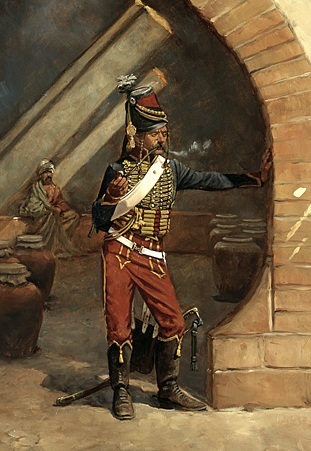This is about wings :
many of them are strapped to the saddle at the upper thigh at 4-6 feet long
Another link with google translation :
pl.wikipedia.org/wiki/Husaria#Uzbrojenie_husarza
Quite odd, but characteristic of the formation of a piece of equipment was the pen. These Feathers, contrary to established schemes, were not only an eagle, falcon often, hawks, and sometimes a raven, and even the geese, which can easily explain the price and availability. Initially, they were worn on hats, helmets, sticks copy discs, with the horses' legs, as well as the famous wings.
To this day, in the minds of Poles is encoded picture hussar with two wings attached to the backplate armor. This is a picture not so much wrong as misleading. Well, a lot more wing or wing (usually used for one) attached to the rear saddle, and that's after the occupation of the hussar of the saddle [note 10]. Very often it was used only for popisach wings and parades. There are several theories to justify the use of wings: the most reasonable seems to be the one that sees feathers, or wings, part of psychological warfare. In fact, the wings could frighten the horses of the enemy, but not the noise, the noise of battle which no one would have heard, but its appearance.
It should be noted that many pieces of equipment hussars had just affect the psyche of the enemy. Flapping and eyes flashing colors mamiły attacked the enemy with copies hussar banners. During his many years in Poland French engineer Guillaume le Vasseur de Beauplan noted:
"At the tips of his back waving banners that are either white and red, or blue-green or black and white. But always remain two-color and 4 to 5 yards long [21]. This is probably designed to frighten enemy horses. Since the [hussars] leave their copies of rushing at the horse pops, banners, these are spinning around, arousing fear the enemy's horses, which they want to break ranks. "[22] Although detailed description, Beauplan no mention in it about using the wings. A common use of wings by the hussars, however, mention the other authors of the seventeenth century visitors to the Commonwealth as Karl Ogier in 1635 [23], Sebastian Cefali in 1665 and Francois Paul D `Alerac in 1689.
The use of the wings of hussars also mention the authors of the eighteenth century as if Jedrzej Kitowicz Steinhauser writes: "They had wings composed of a wooden strip screwed to the waist, high on top of the head, above a curved head, a variety of colors with their feathers painted an olive branch or palm imitating, making oddly beautiful view, but this laurel, not all squadrons have used "[24]. Some seventeenth-century authors emphasized the practical application of the wings "sticking out on the shoulders of their lofty wings to frighten enemies" [23].
With passage of the letter przypowiedniego Stefan Batory Foundation for the haul rota Bielawski hussar, "and the feathers and other ornaments for the grandeur and terror of the enemy depending on the tastes of each" show that the use of feathers was not mandatory. However, it represented widespread custom among the Polish driving record as confirmed by the regulations for the Lithuanian hussars of 1746 years saying, "The ancient custom wings for postal use on sheet metal rear stops." Not all the hussars wore the obligatory piece of equipment, which can also provide images of the era and relationships, not to mention the wings.
In our consciousness Hussar wings grounded until the nineteenth-century painters like Joseph Brandt and Wojciech Kossak and contemporary for us air force and armored units, which in its symbolic use of this element hussar armor. Many hussar armor, appearing today in the existing museum collections, have been fitted with wings only in the nineteenth century and the result is very difficult to determine the actual use of skrzydeł.W many sources using "wings" hussar was the beginning of the battle with the Tartars. Tatars who value captives seized on the so-called jeźców. valuable insight into. Hussar wings mounted either on the back or the saddle, effectively prevented the abandonment of the rope, or facilitate the escape of the loop. Use them to fight another opponent does not matter much but probably because of "terrible appearance" of such a rider were used. In addition to the decoration of feathers visible hussars were skins of wild animals. It is characteristic that usually wore husarscy companions (as an outer garment armor) tiger or leopard skin, while the officers (governors, lieutenants) wolf skins, bears and lynx, which sometimes led to misunderstandings [note 11].
Splendor [edit]
Hussars during the parade in 1605 in Krakow, presented at the Polish Rulonie
Hussars, in the ranks of the unstable distributions of the first families of the sons of the Republic, distinguished by the richness of costume and weaponry. Everything (in addition to those skins) from the gleaming gold and precious stones.
Up to 100 words.I didn`t read this text in Polish at all ( the first one ) , just copied and translated by google and posted here , so I am reading it for the first time , in Polish , now
.But here is a full desription of those wings armour in my last post :):):).

